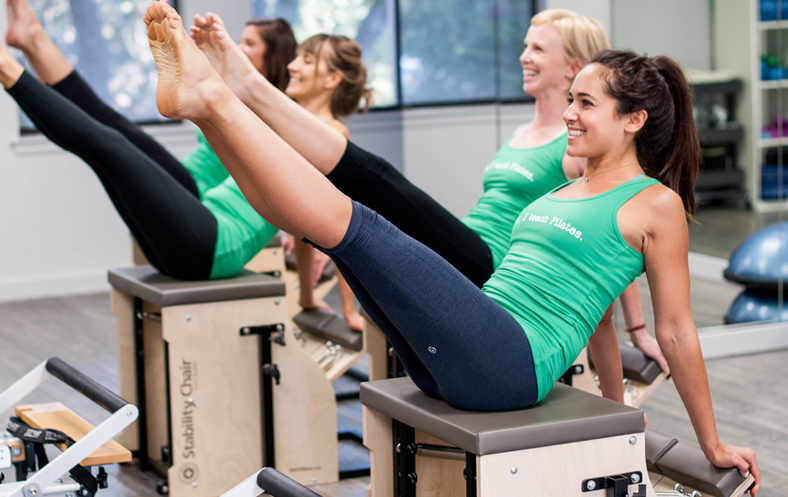Liana Mauro on 10 Ways Pilates Can Help You
in Athletic Injuries / Back Pain / Exercise, Training, and Fitness / Knee Pain / Neck Pain / Posture and Ergonomics
Let’s get one thing straight: I am not a Pilates expert.
I do know a thing or two about staying healthy and injury-free, however. And I know when I’m out of my league when it comes to knowledge about a particular discipline, especially in the health field.
So, when I wanted to learn more about Pilates, and how it could help both me and my patients, I tracked down Liana Mauro. I’ll be posting a full run-down of my experience with Liana and her staff at Mauro Pilates soon.
For now, know this: Liana is patient, careful, observant, and knowledgable about putting together a Pilates regimen that is effective, fun, and safe. I don’t hand over the reigns of my blog frequently, so trust me when I say that you’re in excellent care with the information presented below.
Be sure and read down to the end of the article, where Liana has included an enticing offer. This wasn’t solicited, and I include it here only because Liana is a practitioner I respect and think should be more widely known.
Welcome Liana Mauro….
10 Ways Pilates Helps Heal and Prevent Injuries
For much of my life I had chronic health problems and pain, which led me to Pilates and a variety of alternative health treatments. After moving to Austin I met Dr. Collins, who helped decrease much of my pain through providing chiropractic care, applied kinesiology and nutritional guidance.
I, along with numerous clients I’ve taught over the years, have rehabbed injury and decreased or completely eliminated chronic pain through Pilates. I’m excited to share with these 10 ways Pilates can help heal and prevent injuries.
Enjoy!
- Core Strength
Whether sitting, standing or moving, it is necessary for our core muscles to be working. Core muscles refer to more than the abdominals. They also include the diaphragm, glutes, deep muscles around the spine and pelvic floor, and the deepest layer of abdominals – the transversus abdominus.
In order for these muscles to be ‘functional’ there’s a proper firing pattern that must occur. Pilates teaches neuromuscular re-patterning so that whether performing large and powerful movements or sitting at a desk for several hours, your core postural muscles are able to support you and decrease the spinal load, in turn lowering the chance of injury.
- Alignment
Any time movement happens in poor alignment, performance is decreased because the load on your body goes up, often causing injury. The body is smart and wants to be in alignment. When aligned the body performs better, feels better and even looks better.
For example, the human head weighs about 12 pounds, but research shows that when the neck bends forward and down (otherwise known as ‘text neck’) the weight that the cervical spine has to carry significantly increases: a 15 degree angle causes it to weigh 27 pounds, at 30 degrees its 40 pounds, at 45 degrees its 49 pounds and at 60 degrees its an extra 60 pounds! No wonder so many of our necks hurt!
This particular misalignment has become the norm and not only increases the load on the cervical spine; it leads to compensations in the rest of the body causing more instability and additional weight for joints to carry. Because Pilates exercises emphasize proper alignment, strength gained from sessions allows muscles to support the body in a more aligned position outside of the studio.
One of the many values of a well-trained instructor is that he/she will offer a variety of corrections while you exercise so you can get the most benefit from exercises. Areas you probably don’t think about, like your ankle or hip position actually make huge differences in exercises when adjusted towards neutral.
Clients are often surprised by how much more challenging an exercise becomes when properly aligned. We always say that being aligned helps you functionally and aesthetically: it decreases chance of injury and makes your muscles work harder.
For those of you who love a good burn, exercises performed in alignment are both rehabilitative and more challenging! Another plus? Athletes who perform this type of strength training will become faster and more efficient, which is why so many sports teams are adding Pilates into their training programs.
- Joint Support
For various reasons including overuse from repetitive movement, injury and arthritis, at some point most people experience joint pain. Because Pilates focuses on strengthening the smaller muscle groups, relief from joint pain is a regular experience of practitioners.
These smaller muscle groups are what provide support to joints. Most people have very developed large muscle groups (think quads), without sufficient strengthening for the smaller muscles (think hips). When the large muscles get tired, instead of being supported by the smaller muscle groups, the impact or stress has nowhere to go but to the joints. Overtime this leads to chronic pain, injury or joint damage.
- Strengthens Weak Links
The things your body most needs are often the movements that feel most awkward or difficult. Most of us like doing exercises that are easy, but if that’s the only type of exercise you do, muscular imbalances and chronic pain will only get worse.
Do you like backbends and hate abdominal work? Then there’s a good chance your spine needs more flexion and functional abdominal work in order to allow your spine to work as the amazing shock absorber it’s meant to be. An instructor will help discover the specific areas that need to be stretched or strengthened so that you will be better aligned and able to move with ease. By strengthening weak links in your body, you will feel better and perform more powerfully.
- Balance
Because of its emphasis on alignment, Pilates naturally brings balance to muscles. When opposing muscle groups are able to sufficiently support each other, the chance of injury goes way down.
- Body Awareness
Pilates teaches the value of working at a challenging level without feeling pain in places like your low back, neck and joints. Many people don’t even know it’s possible to work out pain free, but it is! Because of its emphasis on control and awareness, Pilates improves awareness of your body so that whether you’re taking a leisurely walk or doing a powerful movement like sprints, nothing will hurt except for the intended muscle groups (that’s the good hurt!).
- Low Impact
Another thing that sets Pilates apart from other forms of exercise is that it strengthens joints with little to no impact, making it a very safe choice for people with injuries or arthritis. Pilates also offers a unique way to get in low impact cardio by attaching what looks like a tiny trampoline to the end of the reformer (CC’s note: the reformer is a common piece of equipment used in Pilates) so you can jump while lying down! It’s very fun and a great full body workout.
- Full ROM Strengthening
Pilates equipment uses springs to provide resistance, weight or support. Because the spring keeps tension throughout exercises (similar to a fitness band) muscles are able to work through a supportive full range of motion. Muscles that are strengthened this way are that much more strong and functional, allowing for stronger joints. When you are able to strengthen a joint through its full range of motion you are able to create a joint that is incredibly strong and stable versus a joint that is only strong at certain points. Working muscle groups in a decreased range of motion can actually contribute to joint pain.
- Muscular Isolation & Targeting
Concentrating on specific body parts, Pilates allows for very targeted strength training so practitioners are able to target appropriate muscle groups. An example of this is with shoulder injuries involving the rotator cuff. Pilates emphasizes proper shoulder placement and both stabilization and mobilization of the joint. Pilates offers numerous movements that target the rotator cuff offering a safe place to recover from a shoulder injury.
- Control
In Pilates, strength training is done in an environment emphasizing alignment, precision and control. This controlled movement allows practitioners to learn how to utilize their bodies specifically for their needs and limitations. Injured clients feel much more confident and empowered as they learn how to move and position themselves in ways that don’t hurt.
With a knowledgeable instructor, Pilates is an incredibly safe and effective form of exercise to practice when injured or looking to remain injury free. If significantly injured, we recommend taking 1-on-1 private sessions. This being said, we keep our classes small (a maximum of 5 people) because we believe in offering customized sessions to all clients who visit the studio.
We’d love for you to come give us a try. Please visit us at www.mauropilates.com to find our Online Scheduler where you can find promotions specifically for patients of Austin Holistic Health in our Online Store.
CC Note: Liana is an amazing pracitioner, and you should definitely check out her services. Her offer for my patients can be found here.



I’m 68 years old and have a history of failures in competitive sports. I discovered pilates at 65. I take six classes a week, alternating mat and barre classes with reformer classes. I’m thrilled that I am improving my strength and balance at an age that most people experience
declines. An added bonus is the natural emotional high I get from this type of exercise. Do folks need 6 classes a week? No, I do it because I love it.